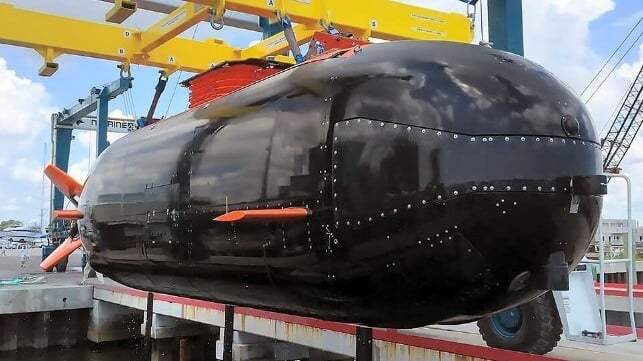Navy SEALs Receive Long-Awaited Dry Minisub

The U.S. Navy SEALs are set to receive full operational access to a long-awaited dry minisub, which will deliver teams to coastal targets without getting them completely wet in the process.
Part of the reasoning behind the SEALs' notorious swim and surf-training program is that their operators have to be able to perform the mission after the rigors of a seaborne insertion, cold and soaking wet. The current generation of SEAL Delivery Vehicles (SDVs) fits in a dry deck shelter on top of a nuclear sub for transport, but the "dry" part ends when the SDV leaves the dry deck. These basic underwater vehicles are open to the elements, and SEALs have to wear wet suits and diving equipment throughout the transit to their destination. This method has few advantages for the operator.
To get SEALs to and from their target in secret - without the limiting effects of fatigue, or for deeper dives, safe decompression - the Navy has pursued a long term R&D program on the development of an enclosed sub with a pressure hull. Called the Dry Combat Submersible (DCS), this special-purpose vehicle has been in various stages of R&D for the past 15 years, and it is finally ready.
On Wednesday, Special Operations Command confirmed that the DCS will be operational by Memorial Day, undersea program manager John Conway told the crowd at the SOF Week conference in Tampa. "We're coming to an end scenario," he said. Delivery was initially expected in 2021.
Two previous attempts to develop a dry minisub for SEAL delivery officially ended in failure. Northrop Grumman attempted to build a similar device in the mid-1990s, the Advanced SEAL Delivery System (ASDS) twice as large as the DCS. The R&D program continued throughout the early years of the War on Terror, but the prototype caught fire in 2008 and the Navy canceled the program the next year. (Two nuclear subs still retain the mounting brackets to carry it on deck.) The second attempt at a dry minisub, the Joint Multi-Mission Submersible, ended almost as soon as it began.
In a third try, Lockheed Martin received a contract to develop the DCS in 2016 in conjunction with UK-based MSubs, a designer of swimmer lockout subs based in the UK. According to MSubs, the unit is 39 feet long, can make speeds up to five knots and can transit 60 nautical miles underwater with eight SEALs on board - at least twice as far as the current-generation wet SDV. The stakes behind this new operational capability are high.
“These are national command authority missions. Can’t fail. So in those niche missions, it’s really important we have technology that’s cutting edge,” then-Rep. Ryan Zinke (R-MT) told the Hill at the outset of the program in 2016.
